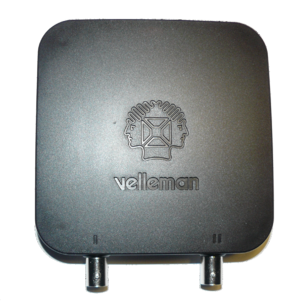Difference between revisions of "Velleman WFS210"
Uwe Hermann (talk | contribs) (Set status to Planned.) |
|||
| (10 intermediate revisions by 2 users not shown) | |||
| Line 1: | Line 1: | ||
[[File:VellemanWFS210 | [[File:VellemanWFS210.png|thumb|right|Velleman WFS210]] | ||
The [http://www.velleman.eu/products/view/?id=416586 Velleman WFS210] is a claimed to be the first WiFi oscilloscope. It has 2 channels, and 10MS/s sampling rate per channel. | The [http://www.velleman.eu/products/view/?id=416586 Velleman WFS210] is a claimed to be the first WiFi oscilloscope. It has 2 channels (8bit), and 10MS/s sampling rate per channel. | ||
Some properties and features: | |||
* Wifi & internal battery for self-contained remote connection to a tablet or PC | |||
* Charges off USB (mini plug) | |||
* Supported on IOS, Android 4, Windows | |||
* Sources for Android build on github | |||
* Protocol description on manufacturers site | |||
See [[Velleman WFS210/Info]] for more details (such as '''lsusb -v''' output) about the device. | |||
== Hardware == | == Hardware == | ||
'''Note''': When taking the device apart, the power button really needs to be removed first / fitted last. Levering the board out without removing the button can damage the switch. Beware! | |||
'''Control logic''' | '''Control logic''' | ||
| Line 28: | Line 22: | ||
'''USB interface''' | '''USB interface''' | ||
* | * Onboard the dsPic | ||
'''Wifi interface''' | '''Wifi interface''' | ||
| Line 43: | Line 37: | ||
'''Power''' | '''Power''' | ||
* 1 x 3.7V 1.8Ah lithium battery | * 1 x 3.7V 1.8Ah lithium battery | ||
* 1 x 7387 | * 1 x 7387 lithium pack charge controller | ||
* 1 x TJ 42MD7LE regulator | * 1 x TJ 42MD7LE regulator | ||
| Line 64: | Line 58: | ||
== Protocol == | == Protocol == | ||
http://www.velleman.eu/downloads/0/information/protocol_wfs210.pdf | The protocol is publically [http://www.velleman.eu/downloads/0/information/protocol_wfs210.pdf documented by the vendor]. | ||
It is described in terms of frames such as <STX> ... <ETX> as though on a serial stream and doesn't mention TCP ports or USB endpoints. | |||
If connected wirelessly, the device offers an address in the range 169.254.1.x, and appoints itself 169.254.1.1. Port 2000 appears to be the only open port (nmap 169.254.1.1 -p-) and telnet to that port returns the connection greeting '*HELLO*' | |||
== Resources == | |||
* Software: | |||
** [https://itunes.apple.com/us/app/wfs210/id933118232?mt=8 iTunes] | |||
** [https://play.google.com/store/apps/details?id=be.velleman.wfs210&hl=en_GB Android] (4.0 or later), [https://github.com/Velleman/aWFS210 Android sourcecode] | |||
** [http://www.velleman.eu/downloads/files/downloads/wfs210setup.zip Windows] | |||
* Manuals: | |||
** [http://www.velleman.eu/downloads/0/infosheets/datasheet_wfs210_uk.pdf Datasheet] | |||
** [http://www.velleman.eu/downloads/0/user/getting_started_wfs210.pdf Quickstart manual] | |||
** [http://www.velleman.eu/downloads/0/user/usermanual_wfs210.pdf User manual] | |||
[[Category:Device]] | [[Category:Device]] | ||
[[Category:Oscilloscope]] | [[Category:Oscilloscope]] | ||
[[Category: | [[Category:Planned]] | ||
Latest revision as of 18:47, 20 December 2016
The Velleman WFS210 is a claimed to be the first WiFi oscilloscope. It has 2 channels (8bit), and 10MS/s sampling rate per channel.
Some properties and features:
- Wifi & internal battery for self-contained remote connection to a tablet or PC
- Charges off USB (mini plug)
- Supported on IOS, Android 4, Windows
- Sources for Android build on github
- Protocol description on manufacturers site
See Velleman WFS210/Info for more details (such as lsusb -v output) about the device.
Hardware
Note: When taking the device apart, the power button really needs to be removed first / fitted last. Levering the board out without removing the button can damage the switch. Beware!
Control logic
- Microchip dsPic33EP256MU806 microcontroller
- 12MHz crystal: clock source for the dsPic
USB interface
- Onboard the dsPic
Wifi interface
- Roving Networks (Microchip) RN171-I/RM
Analog frontend
- 6 x EGE EDR301A0528 reed relays (3 per input channel)
- 6 x variable capacitors (3 per channel)
- 4 x variable resistors (2 per channel)
- 2 x Texas Instruments OPA354 op-amps
- 1 x Microchip 6404E quad op-amp
- 1 x Maxim 1192E 8-bit 22MSPS dual A/D converter
Power
- 1 x 3.7V 1.8Ah lithium battery
- 1 x 7387 lithium pack charge controller
- 1 x TJ 42MD7LE regulator
?
- 8-pin pack marked 'NXC' near TI opamps
Photos
Protocol
The protocol is publically documented by the vendor.
It is described in terms of frames such as <STX> ... <ETX> as though on a serial stream and doesn't mention TCP ports or USB endpoints.
If connected wirelessly, the device offers an address in the range 169.254.1.x, and appoints itself 169.254.1.1. Port 2000 appears to be the only open port (nmap 169.254.1.1 -p-) and telnet to that port returns the connection greeting '*HELLO*'
Resources
- Software:
- iTunes
- Android (4.0 or later), Android sourcecode
- Windows
- Manuals:








